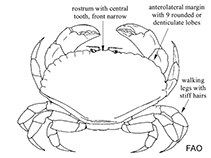Romaleon antennarium (Stimpson, 1856)
California red rock crabGoogle image | No image available for this species;
drawing shows typical species in Cancridae.
Classification / Names Common names | Synonyms | CoL | ITIS | WoRMS
Malacostraca | Decapoda | Cancridae
Environment: milieu / climate zone / depth range / distribution range Ecology
Benthic; depth range 0 - 91 m (Ref. 78494). Temperate; 62°N - 24°N, 168°W - 111°W
Distribution Countries | FAO areas | Ecosystems | Occurrences | Introductions
Eastern Pacific: Alaska to Mexico. Climate: Boreal to subtropical.
Length at first maturity / Size / Weight / Age
Maturity: Lm ? range ? - ? cm Max length : 15.0 cm CW male/unsexed; (Ref. 78494); 12 cm CW (female); max. published weight: 0.00 g
Life cycle and mating behavior Maturity | Reproduction | Spawning | Eggs | Fecundity | Larvae
Main reference
References | Coordinator | Collaborators
Hines, A.H. 1991 Fecundity and reproductive output in nine species of Cancer crabs (Crustacea, Brachyura, Cancridae). Can. J. Fish. Aquat. Sci. 48:267-275. (Ref. 78494)
IUCN Red List Status
(Ref. 130435: Version 2025-1)
CITES status (Ref. 108899)
CMS (Ref. 116361)
Threat to humans
Human uses
Fisheries: commercial
| FishSource |
Tools
More information
Diet composition
Food consumption
Predators
Max. ages / sizes
Length-weight rel.
Length-length rel.
Length-frequencies
Mass conversion
Abundance
Internet sources
BHL | BOLD Systems | CISTI | DiscoverLife | FAO(Publication : search) | Fishipedia | GenBank (genome, nucleotide) | GloBI | Gomexsi | Google Books | Google Scholar | Google | PubMed | Tree of Life | Wikipedia (Go, Search) | Zoological Record



